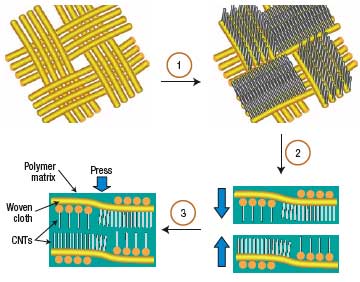| Posted: Jun 02, 2006 | |
Novel nanotube approach leads to significant performance improvement in composite materials |
|
| (Nanowerk Spotlight) The extraordinary mechanical properties of carbon nanotubes (CNTs) have generated strong research interest in their possible use in reinforced composite materials. So far, different studies using carbon-nanotube reinforcements in polymer composites have reported only small improvements in the bulk mechanical properties compared with traditional fiber-reinforced composites. Through a novel approach, researchers have created a CNT-based composite material that exhibits significant improvements in fracture performance and structural damping. | |
| The reason the use of CNTs in composites for structural applications has been disappointing is due to issues such as dispersion, alignment, and interfacial strength. A collaborative research effort between the University of Hawaii and the Rensselaer Polytechnic Institute demonstrates an unexplored yet big opportunity for CNTs in composites. The researchers use CNTs to influence and increase the 3D composite interlaminar properties, using unique reinforced laminae with carbon-nanotube forests grown on cloth fibers present in adjacent plies. | |
| The findings of the research group, led by Professor Mehrdad Ghasemi Nejhad, director of the Hawaii Nanotechnology Laboratory at the University of Hawaii, and Professor Pulickel Ajayan at Rensselaer were published in the May 7, 2006 online edition of Nature Materials ("Multifunctional composites using reinforced laminae with carbon-nanotube forests"). | |
| "In this work, we address major issues in composite materials, as well as nanocomposite materials, using the incredible multifunctional capabilities of CNTs" Vinod Veedu, lead author of the paper, explained to Nanowerk. "They are very strong, highly conductive and have good damping properties. We explored all these possibilities when we incorporated nanotubes into composites through a novel manufacturing method." | |
| "Nanotubes are a very versatile material with absolutely fascinating physical properties, all the way from ballistic conduction to really interesting mechanical behavior, but there are major issues in introducing them to a polymer to make a nanocomposite material" says Ajayan. | |
| The 3-D nanocomposite materials that they introduced, address these issues and they could be well called a revolutionary material. | |
 |
Schematic diagram of the steps involved in the hierarchical nanomanufacturing of a 3D composite. (1) Aligned nanotubes grown on the fibre cloth. (2) Stacking of matrix-infiltrated CNT-grown fibre cloth. (3) 3D nanocomposite plate fabrication by hand lay-up. (Reprinted with permission from the Nature Publishing Group) |
| As reported in the Nature Materials article, the researchers demonstrate a novel approach in grafting well aligned forest of carbon nanotubes on silicon carbide ceramic fiber cloths. The fiber cloths were then infiltrated with a high temperature polymer and then stacked on each other with the carbon nanotubes "sandwiched" in between the layers. The composites thus manufactured were cured in a high temperature furnace. | |
| "Having carbon nanotube Velcro-like fasteners go in the through-thickness direction essentially would ensure the mechanical properties required in that direction" says Ghasemi-Nejhad. | |
| A series of tests showed that the new 3-D nanocomposite material exhibits four times better fracture performance and five-fold increase in their ability to dissipate energy by structural damping in comparison to the original ceramic composites without nanotubes forests. The new nanocomposite material has three times better dimensional stability compared to the base material without CNTs. This could well be the most preferred composite structure for the future structural applications, the researchers say. | |
| "Now, the most interesting fact here is that the new 3-D nanocomposite material that we introduced not only improves structural mechanical properties by several folds, but at the same time they impart multifunctionality to the same structure" says Veedu. "We demonstrated that the novel 3-D nanocomposite performs much better in terms of thermal and electrical conductivities as well." | |
| Previous studies in correcting the through-thickness weakness of traditional fiber-reinforced composites were hampered by various issues, starting with the complexity of manufacturing itself. | |
| "Our findings apply a major concept called hierarchical manufacturing, in which we start from a nano manufacturing process to build up a structural composite material. So this is exclusive hierarchical composite manufacturing process" Veedu comments. | |
| The possibilities offered by this new composite material are intriguing. Just by looking at the aerospace, automotive or marine industries shows how large the market for modern composites already is. The concept introduced by the researchers in Hawaii and New York could be used to make better composite structural materials in these and other areas, leading to high-performance composites with superior mechanical, thermal, electrical and damping properties. | |
| "I believe future composite materials will not only have purely structural aspects, but they increasingly will be multifunctional as well" says Veedu, "and CNT-reinforced nanocomposite materials will play an important role in this." | |
 By
Michael
Berger
– Michael is author of three books by the Royal Society of Chemistry:
Nano-Society: Pushing the Boundaries of Technology,
Nanotechnology: The Future is Tiny, and
Nanoengineering: The Skills and Tools Making Technology Invisible
Copyright ©
Nanowerk LLC
By
Michael
Berger
– Michael is author of three books by the Royal Society of Chemistry:
Nano-Society: Pushing the Boundaries of Technology,
Nanotechnology: The Future is Tiny, and
Nanoengineering: The Skills and Tools Making Technology Invisible
Copyright ©
Nanowerk LLC
|
|
Become a Spotlight guest author! Join our large and growing group of guest contributors. Have you just published a scientific paper or have other exciting developments to share with the nanotechnology community? Here is how to publish on nanowerk.com.
